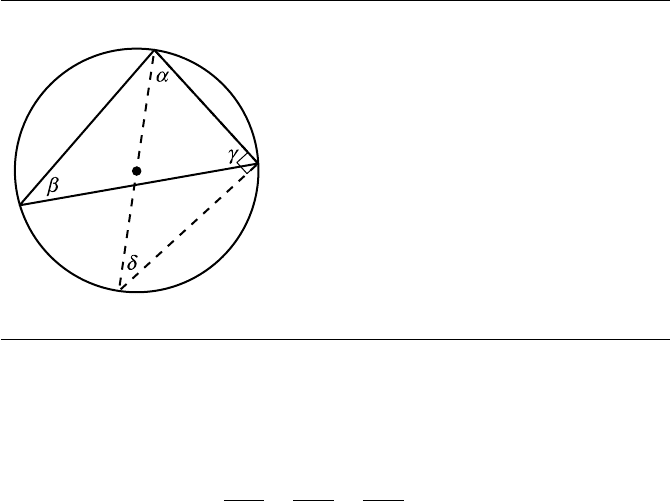Schneider P., Eberly D.H. Geometric Tools for Computer Graphics
Подождите немного. Документ загружается.


934 Appendix B Trigonometry
B.2.5 Integration
sin udu=−cos u + C
cos udu= sin u + C
tan udu= ln
|
sec u
|
+ C
cot udu=−ln
|
sin u
|
+ C
sec udu= ln
|
sec u + tan u
|
+ C
= ln
tan
1
4
π +
1
2
u
+ C
csc udu= ln
|
csc u − cot u
|
+ C
= ln
tan
1
2
u
+ C
B.3 Trigonometric Identities and Laws
Consider Figure B.4, and apply the Pythagorean Theorem. The following relationship
holds:
x
2
+ y
2
= r
2
If we apply a little arithmetic manipulation and the definitions of the sin and cos
functions, we get
x
2
+ y
2
= r
2
x
2
+ y
2
r
2
= 1 Dividing both sides by r
2
sin
2
θ + cos
2
θ = 1 Using the definition of sin and cos

B.3 Trigonometric Identities and Laws 935
The next set of fundamental identities involves the negation of an angle. Consider
an angle θ and the definitions found in Section B.2.1. If we consider an angle −θ,we
can see that the terminal side of such an angle intercepts the unit circle at the same
x-coordinate as does the terminal side of θ , but the y-coordinate is negated (observe
Figure B.5). We can then, using the definitions given in Section B.2.1, define
sin (−θ) =
−y
r
=−
y
r
=−sin θ
and
cos (−θ) =
x
r
= cos θ
and
tan(−θ) =
−y
r
=−
y
r
=−tan(θ)
B.3.1 Periodicity
The graphs of the trigonometric functions shown in Figure B.7 make it appear that
the trigonometric functions are periodic, and inspection of the definitions given in
Section B.2.1 reveals that the trigonometric function values for all angles sharing a
common terminal side are the same. Thus, it is true by definition and the observation
that a circle comprises 2π radians that
sin θ = sin(θ ± 2nπ)
cos θ = cos(θ ± 2nπ)
csc θ = csc(θ ± 2nπ)
sec θ = sec(θ ± 2nπ)

936 Appendix B Trigonometry
for all n = ..., −2, −1, 0, 1, 2, .... However, the tangent and cotangent functions
haveaperiodofπ :
tan θ = tan(θ ± nπ)
cot θ = cot(θ ± nπ)
for all n = ..., −2, −1, 0, 1, 2, ....
B.3.2 Laws
This section discusses three laws that define relationships between general triangles’
edges, angles, and trigonometric functions.
Law of Sines
The law of sines is one of the fundamental trigonometric relationships, and it relates
to general triangles, not only right triangles (see Figure B.8). Informally put, the law
of sines states that for any triangle, the ratios of each side to the angle opposite are all
equal
a
sin α
=
b
sin β
=
c
sin γ
= 2r
where r is the circumradius (the radius of the circle passing through the triangle’s
vertices).
The following proof is due to Ronald Goldman (1987):
2Area(ABC) =(A − B) × (C − B)=ca sin β
2Area(BCA) =(B − C) × (A − C)=ab sin γ
2Area(CAB) =(C − A) × (B − A)=bc sin α
∴ ca sin β = ab sin γ = bc sin α
∴
a
sin α
=
b
sin β
=
c
sin γ
The relationship to the circumradius can also be easily proved. Consider again
our triangle ABC; choose any vertex, and draw a line from it, through the circum-
center (the center of the circle that passes through a triangle’s vertices), and intersect-
ing the circle at a point D (Figure B.9).

B.3 Trigonometric Identities and Laws 937
B
A
C
a
c
b
r
Figure B.8
The law of sines.
We know that
ADC is a right angle because it subtends a semicircle. By defini-
tion of the sine function, we then have
sin δ =
b
AD
But of course δ = β because they both subtend the same arc
AC. Thus,
sin δ = sin β
Substituting, we get
sin β =
b
AD
But since AD passes through the circumcenter, AD =2r, and so we have
sin β =
b
2r
Rearranging, we have
2r =
b
sin β

938 Appendix B Trigonometry
B
D
A
C
a
c
b
Figure B.9 Proof of the law of sines.
Combined with the previous proof, we can then conclude
a
sin α
=
b
sin β
=
c
sin γ
= 2r
The Law of Cosines
The law of cosines is another frequently useful relationship and may be viewed as a
generalization of the Pythagorean Theorem to all triangles.
For any triangle with sides a, b, and c,ifθ is the angle opposite side c, then
c
2
= a
2
+ b
2
− 2ab cos θ
The proof is again due to Goldman (1987):
c
2
=B −A
2
= (B − A) · (B − A)
= [(B − C) +(C −A)]· [(B − C) +(C −A)]
= (B − C) ·(B − C) + (C − A) · (C − A) − 2(A − C)(B − C)
=B −C
2
+C −A
2
− 2A − CB − C cos C
= a
2
+ b
2
− 2ab cos C

B.3 Trigonometric Identities and Laws 939
Law of Tangents
The law of tangents states that in any triangle, the ratio of the difference between two
sides to their sum is the same as the ratio of the tangent of half the difference of the
opposite angles to the tangent of half their sum. Again, referring to Figure B.8, we
have
a +b
a −b
=
tan
α+β
2
tan
α−β
2
The proof, due to the “Math Forum” Web site (http://forum.swarthmore.edu/
dr.math), is as follows. Consider the addition and subtraction formulas for the sine
function:
sin(t + u) = sin(t) cos(u) + cos(t ) sin(u)
sin(t − u) = sin(t) cos(u) − cos(t ) sin(u)
Adding and subtracting, respectively, each of these with themselves gives
sin(t + u) + sin(t − u) = 2 sin(t) cos(u)
sin(t − u) + sin(t − u) = 2cos(t) sin(u)
If we let t = (α +β)/2 and u = (α −β)/2, then t + u = α and t − u = β, giving us
sin(α) + sin(β) = 2 sin((α + β)/2) cos((α −β)/2)
sin(α) + sin(β) = 2cos((α + β)/2) sin((α −β)/2)
We can then take the ratio of these two equations, giving us
tan((α +β)/2)
tan((α −β)/2)
=
sin((α +β)/2) cos((α − β)/2)
cos((α + β)/2) sin((α − β)/2)
=
2 sin((α + β)/2) cos((α − β)/2)
2cos((α +β)/2) sin((α −β)/2)
=
sin(α) + sin(β)
sin(α) − sin(β)
which, by the law of sines, is equal to
a +b
a −b

940 Appendix B Trigonometry
B.3.3 Formulas
This section presents a number of fundamental formulas that are occasionally useful
in solving geometric problems.
Mollweide’s Formula
If you are solving a problem consisting of computing vertices and/or edges of a
triangle, given (sufficient) other information about the triangle, relationships such as
the laws of sines, cosines, and tangents can be used to find the solution. Mollweide’s
and Newton’s formulas can be used to verify such solutions because they both involve
all three vertices and all three edges of the triangle.
b − c
a
=
sin
B−C
2
cos
A
2
Newton’s Formula
b + c
a
=
cos
B−C
2
sin
A
2
Area Formula
For right triangles, the area formula A = 1/2 base × height is easy to compute;
however, for a general triangle it is not so convenient. A more general formula may
be used instead:
A =
bc sin α
2
=
ac sin β
2
=
ab sin γ
2
Addition and Subtraction Formulas
You frequently run into problems that require the use of trigonometric functions of
the sum or difference of two angles, where you already have values for the trigono-
metric functions for each angle individually. These are given below:
sin(α +β) = sin α cos β + cos α sin β
sin(α −β) = sin α cos β − cos α sin β
cos(α + β) = cos α cos β − sin α sin β
cos(α − β) = cos α cos β + sin α sin β

B.3 Trigonometric Identities and Laws 941
tan(α +β) =
tan α + tan β
1 − tan α tan β
tan(α −β) =
tan α − tan β
1 + tan α tan β
cot(α +β) =
cot α cot β −1
cot α + cot β
cot(α −β) =
cot α cot β +1
cot α − cot β
You also run into problems that require the use of sums of trigonometric func-
tions of two angles:
sin α + sin β = 2 sin
α + β
2
cos
α − β
2
sin α − sin β = 2cos
α + β
2
sin
α − β
2
cos α +cos β = 2cos
α + β
2
cos
α − β
2
cos α −cos β =−2 sin
α + β
2
sin
α − β
2
tan α + tan β =
sin (α + β)
cos α cos β
tan α − tan β =
sin (α − β)
cos α cos β
Product Formulas
sin α sin β = cos
α − β
2
− cos
α + β
2
sin α cos β = sin
α + β
2
+ sin
α − β
2
cos α cos β = cos
α − β
2
+ cos
α + β
2
cos α cos β = cos
α + β
2
− cos
α − β
2

942 Appendix B Trigonometry
Double-Angle Formulas
sin 2α = 2 sin α cos α
=
2 tan α
1 + tan
2
α
cos 2α =cos
2
α − sin
2
α
= 2cos
2
α − 1
= 1 − 2 sin
2
α
=
1 − tan
2
α
1 + tan
2
α
tan 2α =
2 tan α
1 − tan
2
α
cot 2α =
cot
2
α − 1
2cotα
Triple-Angle Formulas
sin 3α =3 sin α −4 sin
3
α
cos 3α = 4cos
3
α − 3cosα
tan 3α =
3 tan α −tan
3
α
1 − 3 tan
2
α
Quadruple-Angle Formulas
sin 4α = 4 sin α cos α −8 sin
3
α cos α
cos 4α =8cos
4
α − 8cos
2
α + 1
tan 4α =
4 tan α − 4 tan
3
α
1 − 6 tan
2
α + tan
4
α

B.3 Trigonometric Identities and Laws 943
General Multiple-Angle Formulas
There are two different approaches to defining these. The first is based on a series
involving powers of the functions
sin nα = n sin α cos
n−1
α −
n
3
sin
3
α cos
n−3
α +
n
5
sin
5
α cos
n−5
α − ...
cos nα =cos
n
α −
n
2
sin
2
α cos
n−2
α +
n
4
sin
4
α cos
n−4
α − ...
and the second is defined in terms of combinations of lesser multiples:
sin nα = 2 sin (n − 1)α cos α − sin (n − 2)α
cos nα =2cos(n − 1)α cos α − cos (n − 2)α
tan nα =
tan (n − 1)α + tan α
1 − tan (n − 1)α tan α
Selected Exponential Formulas
sin
2
α =
1 − cos 2α
2
sin
3
α =
3 sin α −sin 3α
4
sin
4
α =
3 − 4 cos 2α +cos 4α
8
cos
2
α =
1 + cos 2α
2
cos
3
α =
3cosα +cos 3α
4
cos
4
α =
3 + 4 cos 2α +cos 4α
8
tan
2
α =
1 − cos 2α
1 + cos 2α
